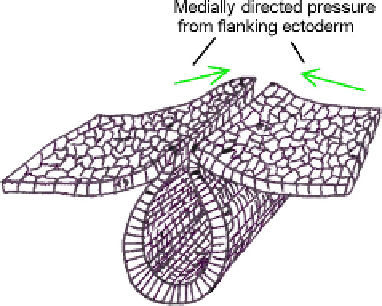Biology Reference
In-Depth Information
FIGURE 18.11
Meeting of the dorsal parts of the neural tube (the neural folds) is driven at least in part by
medial expansion of the surrounding ectoderm, driven by cell flattening and orientated mitosis.
constriction of cells, making wedge-shapes with narrow bases and wider apices. Mutations of
the extracellular matrix protein laminin allow cell shortening to take place but there is no
basal constriction and invagination.
31
This is at least compatible with the idea that both direc-
tions of folding require both internal, cytoskeleton-driven construction and matrix
mechanics. In the case of basal constriction, though, the role of the extracellular matrix cannot
be to resist contraction, as the basal area of cells does decrease.
The elevation of the neural folds and their subsequent meeting contrasts with plate thick-
ening and cell wedging in that it seems not to be driven by purely local mechanisms and it
will not take place if the neural plate is isolated from its flanking ectoderm.
19
The critical non-
local influence may be simple mechanical pressure from nearby ectoderm, which expands
medially and pushes the edges of the neural folds upwards and together. The medial expan-
sion of the ectoderm seems to be driven by cells contracting apicobasally so that the once-
cuboidal epithelium becomes squamous and its surface area increases.
32
There may also be
a degree of convergent extension: certainly mutations in components of planar cell polarity
systems, such as Prickled, are associated with defective closing of the human neural tube.
33
The medial advance of the epithelium may also involve orientated mitoses (see Chapter 23)
in the medio-lateral axis.
34
I
NVAGINATION WITHOUT TUBE FORMATION
Epithelial folding is often used as a means of increasing the surface area for substance
exchange within an organ, with no aim of subsequent tube formation. The mammalian colon
develops from an initially smooth-walled tube of stratified (multilayered) epithelium to
become highly folded. The process of colon folding will take place if sections of hindgut
are removed from the foetus and placed in culture. The mechanism driving folding must
therefore be endogenous to the organ rather than relying, for example, on pressure from else-
where in the embryo. As in neurulation, the process seems to begin when stripes of F-actin
fibres appear at putative hinge points, spaced irregularly along the epithelium. These zones


